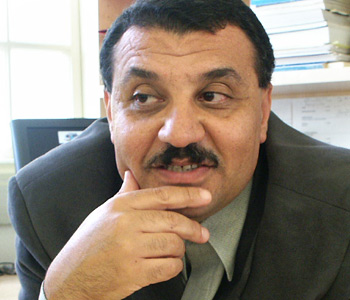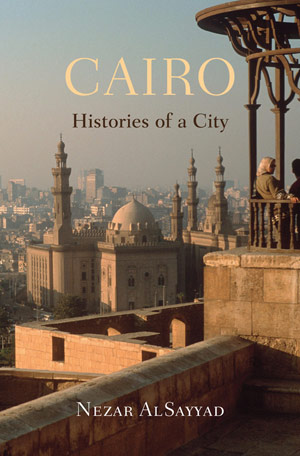
Cairo is composed of twelve vignettes, arranged by place rather than time. Each vignette carries stories told through the place’s built environment. Each edifice has been dictated by the environment (for example, the changing course of the Nile), the needs of the people (an increase in population has created a need for a new marketplace), and the grandiosity of the ruler sponsoring the edifice. Each addition or adaptation to the built environment tells a story of the people who lived in that time, and the ones before it. Many of Cairo’s architectural features have been witness to a thousand years of changes.
The premise of the book is that the history of a city is mainly that of specific individuals, places, and events. I begin each chapter at a specific place that best represents a period in Cairo’s history, and then proceed to describe that time period and the lives of specific individuals, narrating important events, and citing the reports of specific travelers and local residents, all the while attempting to evoke a sense of the evolving spatial order of the city.
“In a globalizing era, when cities no longer belong exclusively to their people, the image of the thing will come to replace the thing itself.”
Cairo has fascinated me since I was first exposed to the city’s Islamic heritage in 1973, and it has continued to keep me under its spell. This love affair began to wane by the early 1990s, however, when my appreciation for the city began to be tempered by the realities of its problems.
By the time I was asked to write this book, in 2006, I had published two other books on various aspects of Cairo and had spent many years devoted to Cairo-related research. But I had been reluctant to write a book on the history of the entire city. The task, I thought, was dangerous and impossible, and I had simply assumed that to do it justice would consume my life. It did not, and this book is the outcome of this engagement.
The novels of Egypt’s most distinguished writer, Naguib Mafouz, provides a dense commentary on Cairo as it navigated the twentieth century, presented through the life and times of three generations of the Abdel-Jawad family. Through them, Mahfouz accurately documents Egypt’s coming of age by tracing the changing social relations in this extended Cairene family. In these three books, he moves us very carefully between the tensions of the emptiness of inherited traditions to the challenges facing a new generation in revolt.
Although Mahfouz wrote his trilogy in the middle of the twentieth century, the dynamics that he describes have existed throughout the history of Cairo. The first volume, Bayn al-Qasrayn (translated to English as Palace Walk), was written in the first years following the Egyptian Revolution of 1952, Mahfouz having titled it after the famous space in the medieval core of Cairo. But Bayn al-Qasrayn was also witness to the evolution of Cairo for over a thousand years, from its origins as a royal settlement to its development into a dense cosmopolitan city.
There is, however, a lot more to Cairo than Bayn al-Qasrayn—more than the medieval Fatimid city, or the few cities built nearby that preceded it. Indeed, the first settlement in the metropolitan area we now call Cairo was actually known as Memphis, built more than four millennia ago, near the great pyramids of Giza. A serious history of Cairo should indeed start with Memphis, a city that had survived for twice as long as the Cairo of the Arabs.
But what can be said of Cairo and its history that has not already been told? Perhaps little, or nothing at all! For no city has been as studied as Cairo. Travelers to Egypt, even before the time of Christ, had inscribed their impressions of the area on the pyramids of Saqqara and Giza. Throughout medieval times, travelers who visited the Fatimid city wrote extensive accounts of their journeys. Many residents and administrators of Cairo also produced extensive histories and documentations of the city, all the way into the modern era. And in the twentieth century, many scholars have written detailed histories of the city’s development, while numerous novelists have used it as a backdrop for their plots.
There are many ways to tell the story of a city, and this book simply offers just one.
Of course, my approach has its limitations. For example, some chapters deal with only two decades. On the other hand, certain events and individuals are indeed more consequential to the development of a city than are others.
Similarly, I proceed from the premise that all historical periods are usually uncovered and articulated as clearly bracketed eras not at the time in which they transpire but after many decades or centuries have passed. For this reason, I often narrate the history of a period by relating it in terms of the time of its discovery.
I do not, however, let my method dominate my narrative; when the method cannot accommodate historical evidence, I leave it behind.
The last chapter of Cairo, the grand finale, if you will, speaks to the necessity of knowing the history of the city in order to understand the present.
In a globalizing era, when cities no longer belong exclusively to their people, the image of the thing will come to replace the thing itself. Without knowing the history of Cairo, one would not be able to see that it is now transforming itself into its imagined historical aesthetic, a sort of Disney-like theme park, where restorations of historical sites will be modeled after their modern-day replicas, rather than the other way around.
That is one possible avenue of change. Another is that Cairo will continue to be an innovative city, one that its citizens will continue to shape through their actions and inactions. Recent events in Cairo suggest the second path.
Not only has this book required me to delve into many histories and different historical methods—it has also forced me to adjust my role as a historian. The choices I have made, in terms of which historical periods to cover (although I try to cover most of the significant ones), which historical characters to single out (again, I try to include all of the noteworthy figures, at least as far as the development of the city is concerned), and in which places to anchor my stories (and here I have had to leave out many), are all part of a broader historical method, rather than just a style of writing.
Writing this book has convinced me that there is no history without historians—with all the biases, frailties, and limitations of their methods. The book also reminds me of an old conviction: history is always written from the present moment, and possibly in the service of it. No history is innocent of contemporary demands. From this perspective, history is neither simply the knowledge of things that have occurred in the past nor the memory of these past events; rather, it is the convergence of these events with certain individuals and in specific places, as discussed and interpreted by others removed from the time and place in which the events occurred.
An underlying assumption behind this work is a fundamental belief that the institutional structure of a society, based on who governs it and how, is often reflected in the places this society produces. Again, this assumption affords methodological limits, because urban form is very complex and cannot be looked upon simply as a language that can just be read. Such reading would be meaningless without the qualifications of social and economic history. At best, the shape of a city becomes a road map for deciphering its history.
“History is neither simply the knowledge of things that have occurred in the past nor the memory of these past events; rather, it is the convergence of these events with certain individuals and in specific places, as discussed and interpreted by others removed from the time and place in which the events occurred.”
Cairo presents a progression of events, through which one can see a pattern. With this historical pattern we can attempt to predict the progression of future events in Cairo. Each event, each change, signals another, just as the events of the years leading up the Arab Spring signaled its arrival. Cairo is a vibrant, alive, and constantly changing metropolis that shapes the lives and imaginations of millions of people.
Under the best possible conditions, the act of writing history consists of piecing together fragments. The process unavoidably leads to resolving contradictions between bits of evidence to arrive at a reasonably substantial version of what has occurred. We inevitably exercise judgment in qualifying which sources are more reliable than others. All these problems are compounded when, as historians, we set out to construct a narrative whose strength lies in its ability to convey precise representations of urban form and space.
But in the final analysis, we must remember that the writing of history will always be, first and foremost, an art of interpretation, not a science of representation. The stories that we depict will change from time to time and from place to place to reflect the interpretations of those who tell them and the interests of the people for whom they are written. The challenge in the telling of history today perhaps lies in reversing the equation and finding the proper balance between what I call the science of interpretation and the art of representation.
In this work, I have attempted to let the multiple histories of Cairo speak for themselves. I am, however, very conscious of how this exercise is enmeshed in a politics of representation in which I play a part. Because I operate mainly in the space between the words and the images, I am perhaps another Baudelairean flâneur who wanders through the city’s history with his mind instead of seeing its actual streets with his eyes.
The great novelist Italo Calvino once wrote that cities are like dreams: their rules seem absurd, their perspectives are often deceitful, and everything in them conceals something else. He tells us that we should take delight not in a city’s wonders, whether these number seven or seventy, but in the answers a city can give to questions we pose, or in the questions it asks us in return. It is only in the context of this wisdom that I have attempted to write this history of Cairo.


Nezar AlSayyad is an architect, planner, urban designer and urban historian. He is a Professor of Architecture, Planning, Urban Design, and Urban History at the University of California at Berkeley. In 1988, AlSayyad co-founded the International Association for the Study of Traditional Environments (IASTE) and he continues to serve as its President. He is also the Editor of the journal Traditional Dwellings and Settlements Review. AlSayyad has authored and edited several books on housing, identity, tradition, urbanism, urban design, urban history, urban informality, tourism and the virtual world.